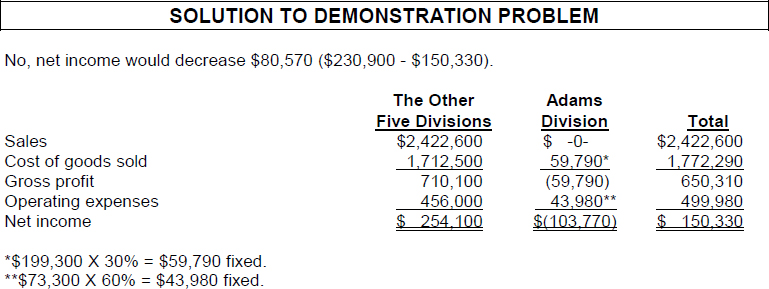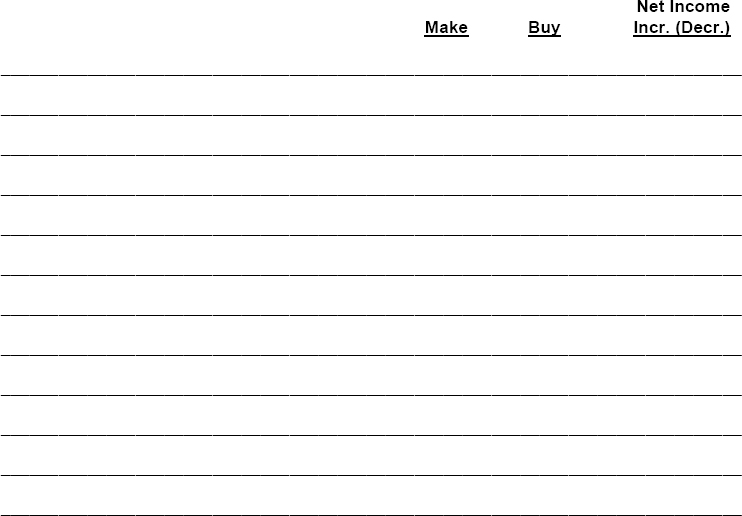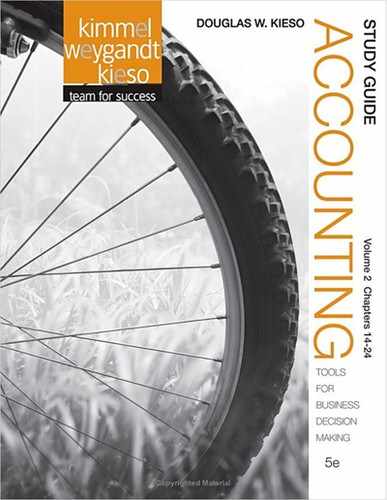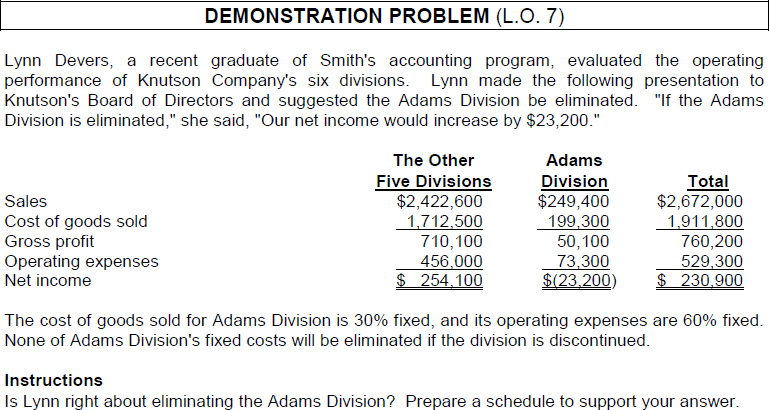Chapter 20
INCREMENTAL ANALYSIS
CHAPTER LEARNING OBJECTIVES
After studying this chapter, you should be able to:
- Identify the steps in management's decision-making process.
- Describe the concept of incremental analysis.
- Identify the relevant costs in accepting an order at a special price.
- Indicate the relevant costs in a make-or-buy decision.
- Identify the relevant costs in determining whether to sell or process materials further.
- Identify the relevant costs to be considered in repairing, retaining, or replacing equipment.
- Identify the relevant costs in deciding whether to eliminate an unprofitable segment or product.
PREVIEW OF CHAPTER 20
An important purpose of management accounting is to provide management with relevant information for decision making. This chapter explains management's decision-making process, and a decision-making approach called incremental analysis. The content and organization of this chapter are as follows:

Incremental Analysis
- (L.O. 1) Management's decision-making process frequently involves the following steps:
- Identify the problem and assign responsibility.
- Determine and evaluate possible courses of action.
- Make a decision.
- Review the results of the decision.
Accounting's contribution to the decision-making process occurs primarily in steps (b) and (d).
- (L.O. 2) Business decisions involve a choice among alternative courses of action. In making such decisions, management ordinarily considers both financial and nonfinancial information. The process used to identify the financial data that change under alternative courses of action is called incremental analysis.
- Incremental analysis involves not only identifying relevant revenues and costs, but also determining the probable effects of the decision on future earnings.
- Data for incremental analysis involves estimates and uncertainty.
- Gathering data may involve market analysts, engineers, and accountants.
- In incremental analysis, both costs and revenues may change. However, in some cases (1) variable costs may not change under the alternative courses of action, and (2) fixed costs may change.
Accept an Order at a Special Price
4. (L.O. 3) An order at a special price should be accepted when the incremental revenue from the order exceeds the incremental costs.
a. It is assumed that sales in other markets will not be affected by the special order.
b. If the units can be produced within existing plant capacity, generally only variable costs will be affected.
Make or Buy
5. (L.O. 4) In a make or buy decision, management must determine the costs which are different under the two alternatives. If there is an opportunity to use the productive capacity for another purpose, opportunity cost should be considered. Opportunity cost is the potential benefit that may be obtained by following an alternative course of action. This cost is an additional cost of making the component.
Sell or Process Further
6. (L.O. 5) The basic decision rule in a sell or process further decision is: Process further as long as the incremental revenue from such processing exceeds the incremental processing costs. Incremental revenue is the increase in sales which results from processing the product further.
Repair, Retain, or Replace Equipment
7. (L.O. 6) In a decision to repair, retain, or replace equipment, management compares the costs which are affected by the alternatives. Generally, these are variable manufacturing costs, the cost to repair, and/or the cost of the new equipment.
a. The book value of the old machine is a sunk cost which does not affect the decision. A sunk cost is a cost that cannot be changed by any present or future decision.
b. However, any trade-in allowance or cash disposal value of the existing asset must be considered.
Eliminate an Unprofitable Segment or Product
8. (L.O. 7) In deciding whether to eliminate an unprofitable segment or product, management should choose the alternative which results in the highest net income. Often fixed costs allocated to the unprofitable segment or product must be absorbed by the other segments or products. It is possible, therefore, for net income to decrease when what appears to be an unprofitable segment or product is eliminated.
9. Many of the decisions involving incremental analysis also have important qualitative features.

REVIEW QUESTIONS AND EXERCISES
TRUE—FALSE
Indicate whether each of the following is true (T) or false (F) in the space provided.
MULTIPLE CHOICE
Circle the letter that best answers each of the following statements.
- (L.O. 2) A number of different types of decisions may be made by management that involve incremental analysis. Which of the following types of decisions do not involve incremental analysis?
- Retain or replace equipment.
- Make or buy.
- Sell products or process them further.
- All of the above are considered to involve incremental analysis.
- (L.O. 3) It costs Crabbe Company $26 per unit ($18 variable and $8 fixed) to produce their product, which normally sells for $38 per unit. A foreign wholesaler offers to purchase 2,000 units at $21 each. Crabbe would incur special shipping costs of $2 per unit if the order were accepted. Crabbe has sufficient unused capacity to produce the 2,000 units. If the special order is accepted, what will be the effect on net income?
- $2,000 decrease.
- $2,000 increase.
- $6,000 increase.
- $36,000 increase.
- (L.O. 3) Its costs Pineda Company $38 per unit ($25 variable and $13 fixed) to produce its product, which normally sells for $52 per unit. A foreign wholesaler offers to purchase 4,000 units at $30 each. Pineda would incur special shipping costs of $4 per unit if the order were accepted. Pineda has sufficient unused capacity to produce the 4,000 units. If the special order is accepted, what will be the effect on net income?
- $4,000 increase.
- $2,000 decrease.
- $4,000 decrease.
- $8,000 decrease.
- (L.O. 3) Geis Company produces 40,000 printers per month, which is 80% of plant capacity. Variable manufacturing costs are $80 per unit, and fixed manufacturing costs are $1,200,000, or $30 per unit. The printers are normally sold directly to retailers at $150 each. Geis has an offer from a foreign wholesaler to purchase an additional 4,000 printers at $100 per unit. Acceptance of the offer would not affect normal sales of the product, and the additional units can be manufactured without increasing plant capacity. What is the amount of increase (decrease) to net income if Geis accepts the order?
- ($200,000)
- ($ 40,000)
- $ 40,000
- $ 80,000
- (L.O. 4) Which of the following would generally not affect a make or buy decision?
- Selling expenses.
- Direct labor.
- Variable manufacturing costs.
- Opportunity cost.
- (L.O. 4) Opportunity cost is:
- the total difference in costs for two alternatives.
- the potential benefit that may be obtained by following an alternative course of action.
- a cost that cannot be changed by any present or future decision.
- the annual cash inflow from a capital investment.
- (L.O. 4) McAlister Corporation incurs the following annual costs in producing 30,000 floppy drives for computers:
Direct materials $ 60,000 Direct labor 100,000 Variable manufacturing overhead 80,000 Fixed manufacturing overhead 90,000 Total manufacturing costs $330,000 However, if McAlister purchases the floppy drives from another company at a price of $10, what is the increase (decrease) in net income for McAlister?
- ($90,000)
- ($60,000)
- $30,000
- $60,000
- (L.O. 5) Which of the following would generally not affect a sell or process further decision?
- Sales.
- Direct materials.
- Direct labor.
- Fixed manufacturing overhead.
- (L.O. 6) A cost that cannot be changed by any present or future decision is a (an)
- incremental cost.
- opportunity cost.
- sunk cost.
- variable cost.
- (L.O. 7) If an unprofitable segment is eliminated:
- it is impossible for net income to decrease.
- fixed expenses allocated to the eliminated segment will be eliminated.
- variable expenses of the eliminated segment will be eliminated.
- it is impossible for net income to increase.
- (L.O. 7) Many decisions involving incremental analysis have important qualitative features that, while not easily measured, should not be ignored. Which of the following is a qualitative factor that is not easily measured?
- Rent expense.
- Lost morale amongst employees when a line of business is eliminated.
- Increased direct labor costs.
- The opportunity to use productive capacity in some other manner.
Match each term with its definition by writing the appropriate letter in the space provided.

EX. 20-1 (L.O. 4) Calvin Company manufactures its own subassembly units known by the code name “ekrob.” Calvin incurs the following annual costs in producing 40,000 ekrobs:
| Direct materials | $ 60,000 |
| Direct labor | 90,000 |
| Variable overhead | 50,000 |
| Fixed overhead | 80,000 |
| Total | $280,000 |
Calvin can purchase the ekrobs from Hobbes Corporation for $6.00 per unit. If they purchase the ekrobs, only $30,000 of the fixed overhead will be eliminated. However, the vacant factory space can be used to increase production of another product, which would generate annual income of $22,000.
Instructions
Prepare an incremental analysis to determine whether Calvin should make or buy ekrobs.

EX. 20-2 (L.O. 6) King Enterprises is a research analysis firm for television advertisements. On January 1, 2013, management is considering updating its computer system with new software that is estimated to cut labor costs by 10 percent. King's labor costs for the current year are estimated to be $400,000 and would be expected to remain the same the following two years. In addition, the new software has a filing system that will allow for a decrease in the storage of the hardcopy of documents within the facilities by 30 percent. The space opened up from the storage of documents will be used to decrease rent expense by $1,000 per month. If the new software costs $70,000 and is expected to be useful for three years, should King Enterprises purchase it?

SOLUTIONS TO REVIEW QUESTIONS AND EXERCISES
TRUE-FALSE
| 1. (T) | |
| 2. (T) | |
| 3. (F) | The process used to identify the financial data that change under alternative courses of action is called incremental analysis. |
| 4. (F) | Incremental analysis involves not only identifying relevant revenues and costs, but also determining the probable effects of decisions on future earnings. |
| 5. (T) | |
| 6. (T) | |
| 7. (F) | When deciding whether to accept an order at a special price, management should make its decision on the basis of the incremental cost per unit and the expected revenue. |
| 8. (T) | |
| 9. (T) | |
| 10. (T) | |
| 11. (F) | The basic decision rule is: process further as long as the incremental revenue from such processing exceeds the incremental processing costs. |
| 12. (T) | |
| 13. (F) | In a retain or replace equipment decision, the book value of the old machine is a sunk cost which does not affect the decision. |
| 14. (F) | Any trade-in allowance or cash disposal value of an existing asset in a retain or replace equipment decision is relevant. |
| 15. (T) | |
| 16. (F) | Many of the decisions involving incremental analysis have important qualitative features that, while not easily measured, should not be ignored. |
| 17. (T) | |
| 18. (T) | |
| 19. (F) | The concepts in this chapter are consistent with Activity-Based Costing. |
MATCHING
- a
- d
- b
- c
EX. 20-1

The analysis indicates that if the ekrobs are purchased from Hobbes, Calvin will increase net income by $12,000.
EX. 20-2
Yes, the incremental savings of the new software is $86,000 and is calculated as follows:





